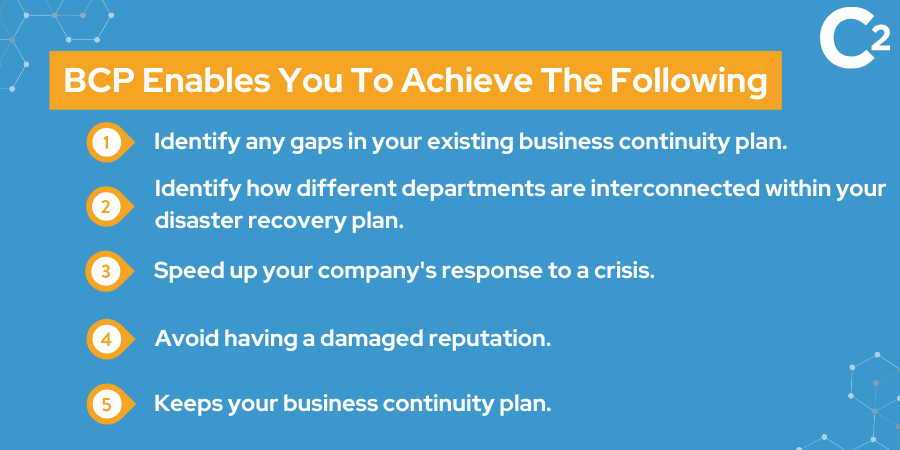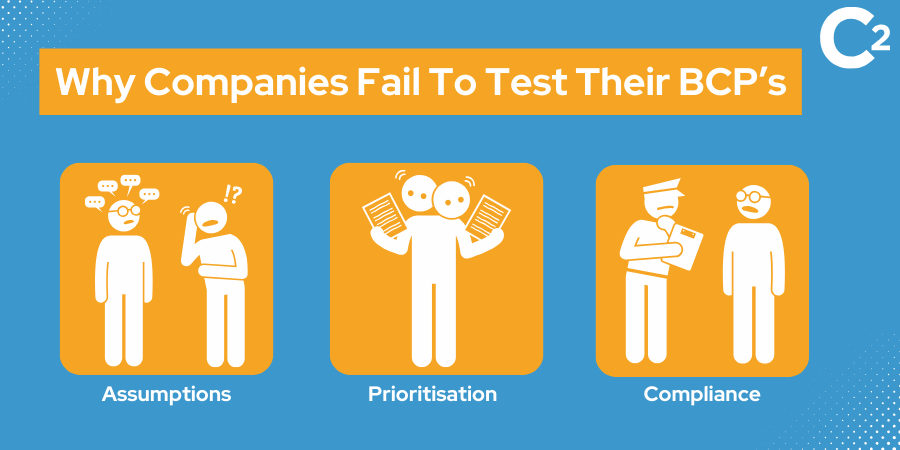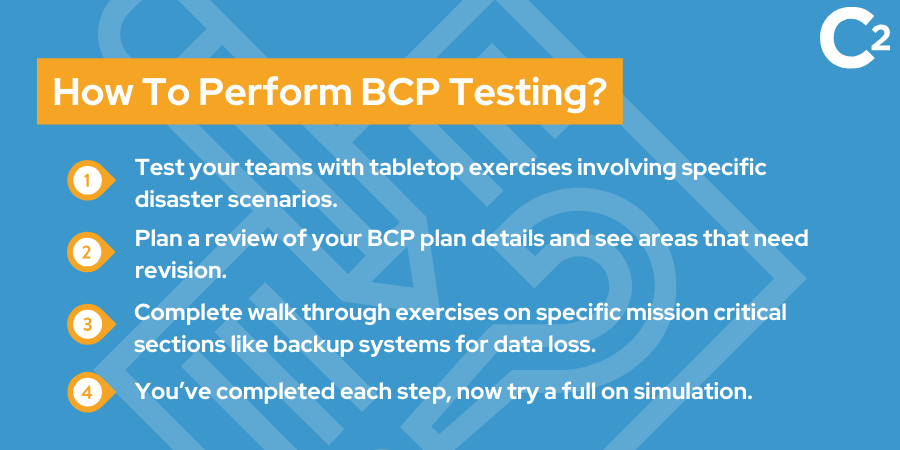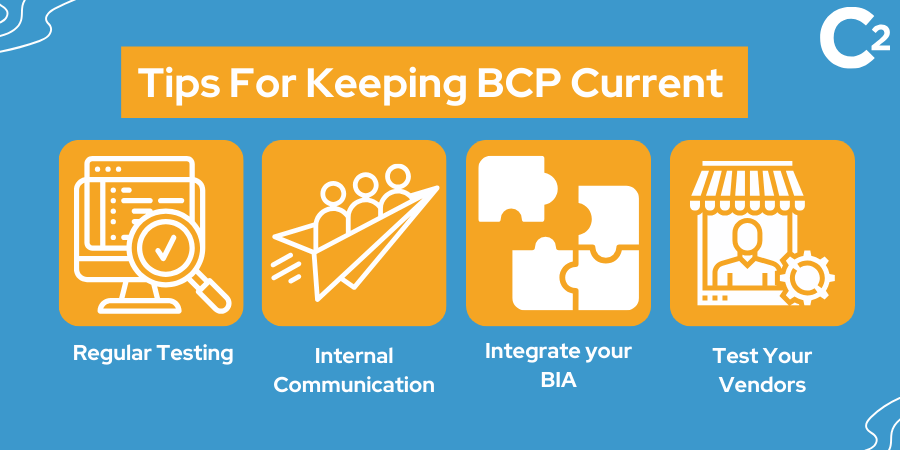What is BCP testing?
Published on November 15, 2022
Last updated on June 25, 2024
Jump to a section
Business continuity planning is only half the battle. An effective business continuity strategy must be effective in multiple scenarios and for various uncontrollable events.
You have put together a team responsible for crisis management and implementing your disaster recovery scenarios. To ensure business continuity, your key personnel must also ensure that these strategies have been tested and reviewed for effectiveness.

BCP testing involves a series of exercises and simulation tests to mimic the effects of the crisis. An effective testing approach must involve various scenarios so your team can handle any situation with ease. Your testing should encompass readiness for different BC incidents, whether a small-scale issue like a power outage or a large-scale event like a cyber attack or a natural disaster.
Why is it essential to conduct BCP testing?
As a business owner, a positive mindset can go a long way. But it isn't particularly helpful if you're conducting a risk management and assessment strategy. You need to anticipate, plan for, and mitigate risks before they occur. If you don't, the entire organisation could crumble and your business continuity would be at risk.
Testing the business continuity plan (BCP) is a must when you are developing your operational resilience strategies. If you are not conducting BC plan testing, you have no way to ensure that the strategy you have in place is the best at managing your perceived risks and threats.
BCP testing enables you to achieve the following:
- Identify any gaps in your existing business continuity plan, develop ways to address them and take corrective actions to increase the plan's maturity.
- Identify interdependencies in various departments of your disaster recovery plan. You can use the test findings to develop a coordinated plan among department heads in the event of a disaster.
- Speed up your company's response to a crisis and ensure compliance requirements are met.
- Avoid having a damaged reputation because you can show your customers resilience during times of crisis.
- Ensure that your business continuity plan is current and updated. Take actionable findings from your business continuity plan testing to identify where improvements are needed.
As a business owner, you have the responsibility to assess your continuity plan and whether regular testing is needed to avoid revenue loss resulting from an inadequate plan.

How often should you perform testing on business continuity plans?
Many businesses perform an annual plan review while others do it every six months. There are no hard and fast rules on the frequency of performing business continuity plan testing. It depends on the unique circumstances and needs of your company, as well as the type and nature of risks.
One thing is definite, though: the more complex the plan is, the more it requires testing and review.
For example, a large multinational organisation will require a more complex business continuity plan than a startup consisting of only five employees. The type of products or services offered by the company will also determine the complexity of the business continuity strategy and the subsequent business continuity tests to be done.
An extensive supply chain has more moving parts and that requires the company to ensure all those parts are working efficiently. Any disruption to the critical component of the company can result in the business temporarily halting operation, or inefficiencies in its operation.
Regulation is another factor that impacts the frequency of testing your business continuity plan. The healthcare and finance industries are two of the most highly regulated industries. If your company is part of this industry, you need to regularly conduct business continuity testing to ensure that you satisfy all the requirements for operation even during disruptive events.
The use of technological tools that automate business continuity plan testing is a smart investment for companies of all sizes. The automated review ensures that you don't have to perform regular manual testing of your business continuity strategy.
Why do you need to keep your BCP plans up to date?
Crafting and updating your business continuity plan (bcp) is crucial for your business when trying to identify key operations, threats to your business, and complying with regulations. Despite its complexity, you shouldn't postpone updating your business continuity plan (bcp), as continuous updates helps your business be resilient to any evolving risks. Neglecting to update your strategies puts your business at danger of ineffective disaster recovery and increased vulnerabilities. In brief, regularly re-evaluating your business continuity plans (bcp) is essential for your organisations survival and adaptability.

BCP plans keep your business competitive
Nowadays, things change rapidly, sticking to old business continuity and disaster recovery plans can leave your company behind. Ignoring new technologies, like advanced BCM software, means missing out on faster crisis response and resilience against disruptions. Also, a modern business continuity management system is crucial for compliance with standards like ISO 22301, making sure you meet legal requirements. Embracing updates to your business continuity plans (bcp) is essential for staying competitive and secure against the potential threats out there.
It protects your businesses reputation
Regularly reviewing and updating your company's recovery plan is crucial for maintaining a strong reputation. This is because it demonstrates a serious commitment from your business to responsibility and adaptability. Keeping your business continuity plan current not only enhances organisational resilience but also signals a proactive stance on risk management. Underscoring the enterprise's dedication to delivering exceptional services, even in crisis recovery.
An Up To Date BCP Can Boost Your Team's Morale
Relying on a static, outdated BCM plan can hold back your organisation. Regularly testing and updating your business continuity plans ensure they remain relevant and can even enhance your team's morale. Involving your employees in business impact analysis can create a sense of ownership and awareness of risks, making every team member feel valued. Their insights can be crucial for innovative solutions and agreements on maintaining critical business functions. Which is why, up to date BCM plans benefit both the company and its employees, building a proactive and inclusive work culture.
How Comprehensive is Your Business Continuity Plan?
Facing an unexpected event with an inadequate response can severely disrupt workflow and delay recovery, a scenario still common in today's business world. Regular evaluations of your business continuity plan can prevent such scenarios, allowing your company to identify and address strategy gaps. Routine testing of protective measures and technology is key to developing solutions for weaknesses. Well planned exercises guarantee essential functions are maintained during disruptions, like testing if insurance company managers can effectively support their teams when standard communication lines fail.
Why do companies fail to test their BCP?
In a nutshell, companies tend to realise how important business continuity planning is when disruptions have already affected their business. There are many factors and reasons why companies don't invest much time and effort in planning and testing, including:
1. Assumptions
Where time, effort and money have already been spent in the creation of a plan, businesses assume that the plan is and will always be effective.
Exercising will highlight assumptions such as whether all staff listed in the plan are available and able to complete their duty as required, if access is prohibited in required areas and for longer than anticipated, and if all IT systems and applications will be restored within expected timeframes and access to data be as expected.
It is these knock-on effects that have to be addressed in exercising, by coming up with solutions and going on to further exercise these.
For example, carrying out regular checks of the company call tree allows a company to evaluate the response rate of staff members and verify telephone numbers communication is of ultimate importance during an incident, and as we know, contact details can change at any time.
The crisis management team should then be able to use the plan effectively during an incident, and the individuals listed in the plan will be better equipped to respond to their assigned duties.
2. Prioritisation
Secondly, where resources are sparse and time and personnel are vital, testing as a priority can get pushed down the list. Lack of commitment, budgets, complacency and buy-in can lead to any scheduled testing getting shelved. These will put your business resilience at risk.
Experience shows that untested plans have a greater likelihood of failure, resulting in lost revenue, damage to reputation and impeded customer fulfilment.
As vital as testing is to the success of BCM, you must however not put the business at risk through the process of testing. As this activity can be time and resource heavy, it can be a complex process which is costly to an organisation of any size. Taking people out of their jobs at critical times, highlighted in your BIA, can be expensive and unnecessary. Good testing should have focus and planning to avoid this.
3. Compliance
Another way in which a lack of exercise and testing can negatively affect a business is the relationship these activities have with compliance. To fulfil the requirements outlined within the official ISO standard for Business Continuity, ISO 22301, exercising and testing must be conducted at regular intervals by an organisation, which must then evaluate and record the findings of these events to continually improve and update its BCMS.
The standard is focused around the 'Plan-do-check-act' management model, and in this case, testing and exercise would fall into the check' step within the model, which is defined by ISO as to monitor and review performance against business continuity policy and objectives, report the results to management for review, and determine and authorise actions for remediation and improvement'.
An organisation therefore must conduct these activities regularly should they wish to certify, or even align with these standards as they certainly will not be successful in doing so if not.

How to Perform BCP Testing
BCP testing should be able to provide you with confidence and validation that the BC and crisis management plans & strategies are feasible, and that all team members and staff are familiar with and understand their roles in the BC process.
Good testing should be focused and varied. There are various ways to test your business continuity plan. Make sure you use all of these methods so you can address various areas of your continuity plan and keep it updated.

Table-Top
The first tier of business continuity plan testing is the tabletop exercise. This testing method involves specific disaster situations and evaluating how your crisis response team deals with these scenarios. The goal of this test is to assess if any gaps weren't previously addressed.
To conduct the tabletop test, you must identify a realistic threat to the organisation. Make sure that this threat is relevant to your industry or organisation. Identify your continuity objectives for performing the tabletop test and create a schedule for how and when it will be conducted.
Use whatever information you obtain in the test, such as strengths and weaknesses, to create a successful continuity plan.
Plan Review
A plan review is like an audit of your business continuity plan details. It involves the business continuity team, department heads, and C-level management. They will take an in-depth look at the plan details to see if any areas need revision or if there are missing components.
The plan review is crucial for managers as they will be responsible for passing on this information to the rest of the employees. It's also a good opportunity to update the contact information of the BCP team as part of the emergency communication strategy.
It is also a type of test that is important if you have new employees. It should be included as part of their onboarding or training.
Walk-Through
A structured or walk through exercise is another example of a test that you can use for the continuity plan. Unlike the tabletop test, this one is more active. It specifically deals with disaster recovery functions, such as restoring backup systems for data loss, verification of redundant systems, and addressing various mission critical functions.
The walk through test will involve the critical personnel who are part of your business continuity team. The critical personnel will be discussing plan details and designate roles on how to respond to a real world disaster and the most disruptive events.
Full Simulation
The full simulation test is another method of testing your continuity plan details. This test must be performed to mimic the effects of a real disaster or disruptive event. You can also conduct a single-team simulation as part of testing a specific team's capacity to respond to specific disaster recovery scenarios.
A full scale exercise is ideally done at full capacity; this means all of your employees and critical personnel are involved in the test. Make sure you undergo the previous exercises before you move on to the full-scale exercise.
Tips for keeping BCP current
Testing your business continuity plan ensures that it fits your organisation's needs. It also minimises the impact of multiple scenarios and disruptive events on the critical component of continuity.

However, test findings update your existing continuity plans to ensure that they are relevant even as the circumstances affecting your company might have changed. The industry and the conditions that it operates in are constantly changing. You have to develop a methodical and systematic review of your continuity plans to meet your specific needs and enable faster recovery.
The following tips will enable you to come up with actionable findings that ensure your continuity planning is relevant and accurate.
Regular testing is a must
Regular tests are important if you want your business continuity planning to succeed. Things are constantly changing in the business landscape. There are known threats to your company and there are also new threats that emerge. Some of the things that were not previously a threat to your business existence might be a significant factor that can lead to revenue loss or damaged reputation.
You need to conduct testing to be able to gather the critical information and plan for how you can prepare for these different scenarios.
Internal communication is key
Communicating the overall risk and benefits that can come from an effective exercise and testing programme should be key to aid buy-in, support and uptake.
Making sure departmental awareness training is up-to-date is vital and makes testing more worthwhile. If an incident does occur and those listed in the plan have been trained and had their roles communicated effectively, then there is a greater chance of executing the plan successfully.
Integrate your business continuity planning with your Business Impact Analysis (BIA)
The most effective and updated continuity plans are those that accurately measure the scale of a disastrous event's impact on your company and its revenue potential.
Test your vendor's continuity plan
This approach is critical if your business relies on an effective supply chain management system. You need to ensure your vendor's success as it is also critical to your business success. It's a good idea to conduct facilitated discussions with critical vendors as they are an integral part of your continuity.
The Bottom Line
A business continuity plan provides your organisation with a blueprint for what steps to take in the event of a disaster. However, continuity planning is only as good as it fits the purpose. BCP testing is one of the ways that you can evaluate if the current plans and measures are aligned with your goals and needs.
Creating the business continuity plan is only the first step. You have more work to do in terms of testing and reviewing the results to ensure that it's doing its job in protecting your company from disruptive events, and enabling you to stay open.
An effective business continuity plan will help your business get through any operational downtime. Utilising a tool or software to assist in your BCP planning, including your testing and exercises can significantly improve your processes and simplify things for everyone involved.
Benefits of using web-based software to aid your Business continuity plan testing
At Continuity2, the Exercising module creates the exercise types according to your specific organisational needs, schedules the test, invites the relevant employees by email, defines the aims of the exercise, and communicates the details to the participants.
Once completed, the software reports on the observations of the exercise and records recommendations and actions raised as a result of the exercise. All reports are distributed and signed off via the software and held within the system for Audit purposes.
Exercises are created and calendared via a simple to use interface where all of the exercises for an entire organisation can be planned and communicated easily, i.e. 15 minutes to plan and document an exercise and 20 minutes to report on the exercise after completion. Post-exercise reports are automatically produced by the system. Actions to improve are automatically captured in the systems action tracking module and included as part of the corrective action or continuous improvement function if desired.
Book a demo today to see the software in action and learn how to maximise your BCP testing processes and results.
Written by Aimee Quinn
Resilience Manager at Continuity2
With an Honours degree in Risk Management from Glasgow Caledonian University and 6+ years in Business Risk and Resilience, Aimee looks after the design and implementation of Business Continuity Management Systems (BCMS) across all clients. From carrying out successful software deployments to achieving ISO 22301, Aimee helps make companies more resilient and their lives easier in the long run.


Written by Aimee Quinn
Resilience Manager at Continuity2
With an Honours degree in Risk Management from Glasgow Caledonian University and 6+ years in Business Risk and Resilience, Aimee looks after the design and implementation of Business Continuity Management Systems (BCMS) across all clients. From carrying out successful software deployments to achieving ISO 22301, Aimee helps make companies more resilient and their lives easier in the long run.